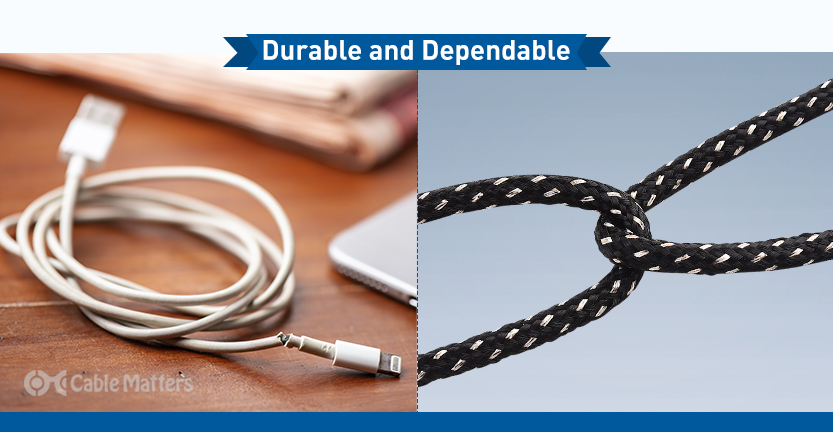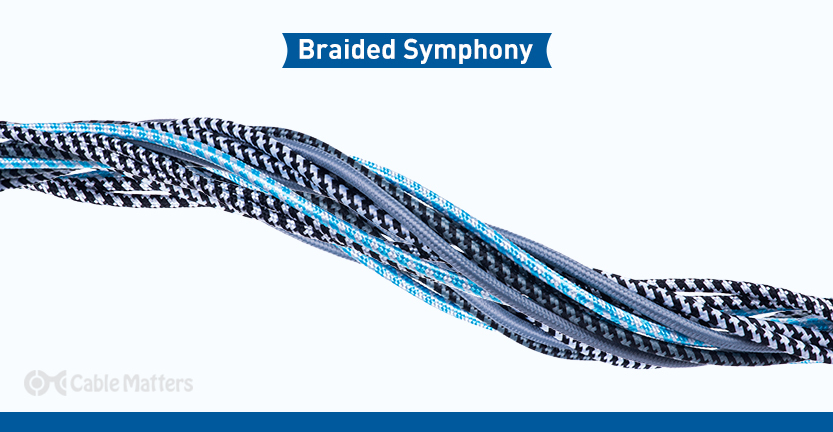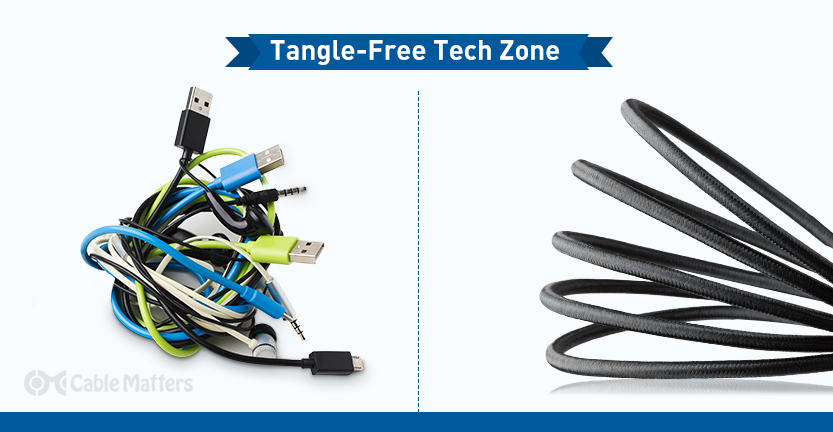.jpg)
Tangled cables are the bane of any modern technology user. Everyone has struggled with tangled headphone wires and spaghetti phone charger cables. Anyone who’s ever reached behind their TV or looked inside their computer will know the potential wire thicket that awaits them, too. That is, unless they’ve been keeping cables untangled with effective cable management.
Not keeping on top of tangled cables can lead to lower performance in the case of some desktop computers, trip hazards in high throughput areas, and clutter and mess everywhere else. Cables can also contribute to workplace errors and a drop in worker efficiency if no one knows where the right cables are for the job at hand. An untidy desk covered in wires can drop your own productivity, too.
To make sure you or your business aren’t impacted by the problems of tangled cables, we recommend you embrace our five key tips on keeping cables untangled, and how to manage them when they do become tangled.
The first, is to use braided cables where and when you can. They’re more durable and can help group wires together for less clutter. You can also use cable organizers to bundle together cables that have a similar role or can be more conveniently run as a group.
Learning effective cable coiling is a great step for anyone who wants to keep their cables from becoming tangled in the future – it’s also an excellent method for longer-term cable storage. Another good practice is using effective labeling and color coding to make sure everyone is aware of what cable does what. Keep an eye on your cables too – effective maintenance of your cables and their connections can prevent issues from arising at critical moments.
Let’s take a look at these individual tips in more detail to see how you can effectively keep your cables untangled.
Embrace Braided Cables
Braided cables – the kind with an external weaved coating, not those with internal EMI protection -- are an important component in protecting modern cables from the elements and from everyday use throughout their lifespan. A braided cable enjoys a significant structural integrity advantage over non-braided cables, ensuring that they last a lot longer; Especially in more demanding environments where they see heavy-handed use.

That outer layer of braided cables has a secondary effect which is particularly important for cable management: it makes the cables less prone to sticking. Where typical silicon cabling has a tendency to get stuck or caught when running alongside other cables of the same type, braided cables can run alongside each other with much less friction. That makes braided cables much less likely to become tangled with any other cable type – though particularly with other braided cables.
Better yet, braiding adds a measure of stiffness to a cable, which in turn makes it run straighter, and gives it a tendency to lean towards straightening itself out when given the opportunity. This makes braided cables less likely to have kinks or twists in the cabling, which in turn makes it even less prone to tangling with other cabling.
Thanks to the effectiveness of cable braiding in preventing tangles and knots, Cable Matters offers a wide range of braided cables so that our customers always have the option of a braided design if they want it. We have everything from braided Thunderbolt 4 cables, offering the highest performance with a reduced chance of tangling, and braided USB-C to 3.5mm cables, among many others you can add to your braided symphony.

If you already have a Cable Matters cable (or any other brand) without braiding, you can also purchase braid sleeves to add to your existing cables. These won’t be as effective as a braid that’s applied to a cable at its point of manufacture, but it does give you the option of improving the durability and reducing the potential for tangling of your existing cable runs.
Use Cable Organizers
Whether you’re trying to cut down on cable mess on the floor of your server room, on your desk, or inside your desktop computer, cable organizers are one of the best ways to reduce clutter, improve airflow, and reduce trip hazards. They help bundle cables together for easier management and labeling, tidy them away so that they aren’t in the way of important tasks or other components, and they can keep cables out of sight if you just want to make your workspace look neater.
There are many different kinds of cable organizers you can use, too. Simple options like cable ties can be great for locking cables down when they have a penchant for spreading themselves out and making a mess of the place. They’re also good for bundling cables of a similar type together, or when they’re traveling to the same destination. Cable ties are also very cheap, easy to use, and can be easily removed with a pair of scissors or wire cutters.
For a reusable alternative, there are velcro cable tidies that perform the same job as a cable tie, but you don’t need to cut them to undo them. Adhesive cable clips and cable holders let you stick your cables into specific places and ensure they stay there. This can be particularly useful for pinning cables to the underside of a desk, or up a wall or piece of furniture since they can be mounted vertically, horizontally, or upside down without difficulty.
By grouping your cables together, you make them much less likely to tangle together or to get in each other’s way. You can also move cables away from areas that you need to work in, or from floor spaces where people need to walk. Cables that run in neat and tidy lines can also look far more aesthetically pleasing. For areas where cables like that will remain in your eyeline, that can help improve your concentration. With cables that you want close to hand for plugging devices like your smartphone or laptop, use a cable holder clip so that you can always reach them easily.
For large collections of cables, or to hide big plugs, surge protectors, or power strips, you can use cable management boxes. If you want to run cables along walls, you might also consider wire covers, which can help you avoid clashes of color between your floors and walls, and the cables. These are often available with adhesive pads to help attach them to a baseboard or door frame, and you can get them in a range of colors and patterns to match your décor.
Practice Effective Coiling
Learning how to effectively coil your cables when they aren’t in use, or when you have a lot of excess cable, can go a long way to reducing your cable clutter – especially in offices and warehouses where you’re storing a lot of equipment. Some cable coiling techniques can result in damage to a cable through overstressing, or may even encourage tangling, so it’s important to use the right one.
There are a few different techniques for coiling cable properly, but the most popular and the one we find the most effective, is known as the “Over under method.” Making sure to be gentle with the cable at all times, follow these steps to become a master of over under cable coiling:
- Place the end of the cable in your hand, with the connector facing away from you.
- Take the cable around an arm’s length back from the connector, and loop it through your hand so that it’s holding the connector end and a single loop of the cable. This is the “over” loop.
- Take a second length of the cable and place it in the original hand again, but this time rotate your second hand around so that you are effectively putting the cable in reverse of the original loop. Your thumbs should touch during the transition between hands. This is the “under” portion of the method.
- Repeat steps two and three until you have coiled the entire cable.
If you spot that one of the loops of cable is notably longer or shorter than previous loops, pause, and redo that loop so that they are more even. Don’t be afraid to halt the coiling method to adjust a loop or all of the coiled cable to be neat and at a uniform length. If you see the cable begin to twist, roll the cable in the opposite direction to unwind it.
You want to maintain a light tension on the cable while it’s being coiled, so that it doesn’t become loose once it’s collected together in a coil. You can also roll the cable in your fingers as you loop it to help retain its shape.
Once you’ve finished coiling the cable, place a velcro strip or cable tie around the entirety of the cable so it retains its shape. This makes it great for hanging or storage, and ensures that the cable is ready to use the next time you need it.
Implement Labeling and Color Coding
If you have a lot of cables in your home, office, or server room, then making sure they are labeled is a good way to ensure you aren’t always having to double-check what everything does before making changes to those cables. Some cables, like fiber optic patch cables, can be color-coded as standard, but that’s not always the case and if you’re using braided cables, that’s not likely to help.
To get around that, you can use color-coded cable boots, color-coded velcro ties, or cable labels – which you can get in varied colors, too. These can simply be wrapped around the cable itself, so can easily be added after installation.
In a pinch, you can even use color-coded tape. That’s a less elegant solution, though, and tape is not easy to remove from cables when wrapped tightly, so be wary of using that if you expect to need to change the coloring or labeling in the future.
Color coding and cable labeling are most important when you are dealing with a lot of cables in complicated setups. At home, this could be useful with a surround sound system, where you want to specifically label your eARC HDMI cable, or make sure the speaker wires are color-coded so you know which goes to which speaker.
In a professional environment, wiring closets can be filled with tens or even hundreds of cables, so color coding and effective labeling are a must to ensure you know what’s what. That can also make maintenance far more straightforward should something go wrong.
Regular Maintenance Matters
Maintenance is something that no one wants to do, but everyone can benefit from. Your cables will stay untangled for a long time if you manage them effectively, learn to use proper coiling techniques, and use robust labeling and organizing. But that’s no guarantee that they’ll stay that way forever. That’s especially true in enterprise settings where other staff may move through an area, and especially so if you aren’t the only person interacting with those cables. At home, kids can be equally chaotic when it comes to keeping cables untangled.

Periodically checking on your cables is the first step in preventing them from becoming tangled. You can re-coil any cables that have come loose, replace any damaged or defective cables, and ensure that all labels are up to date and still legible. You can also adjust your use of cable organizers for more efficient layouts.
Conclusion
Here at Cable Matters, we spend all day every day working with cables, so we know our way around keeping them well-managed and organized. These top tips make sure our own office and warehouse cabling is neat, tidy, and intuitive to work with due to extensive labeling and color coding.
If you work with a lot of cables at your job or even at home, make sure that you use braiding where possible, use the most effective cable organizers for the job, learn how to coil unused and excessive cabling effectively, and implement proper labeling and color coding. Don’t forget to check on the cables now and again, too, to make sure all your hard work continues to pay off.